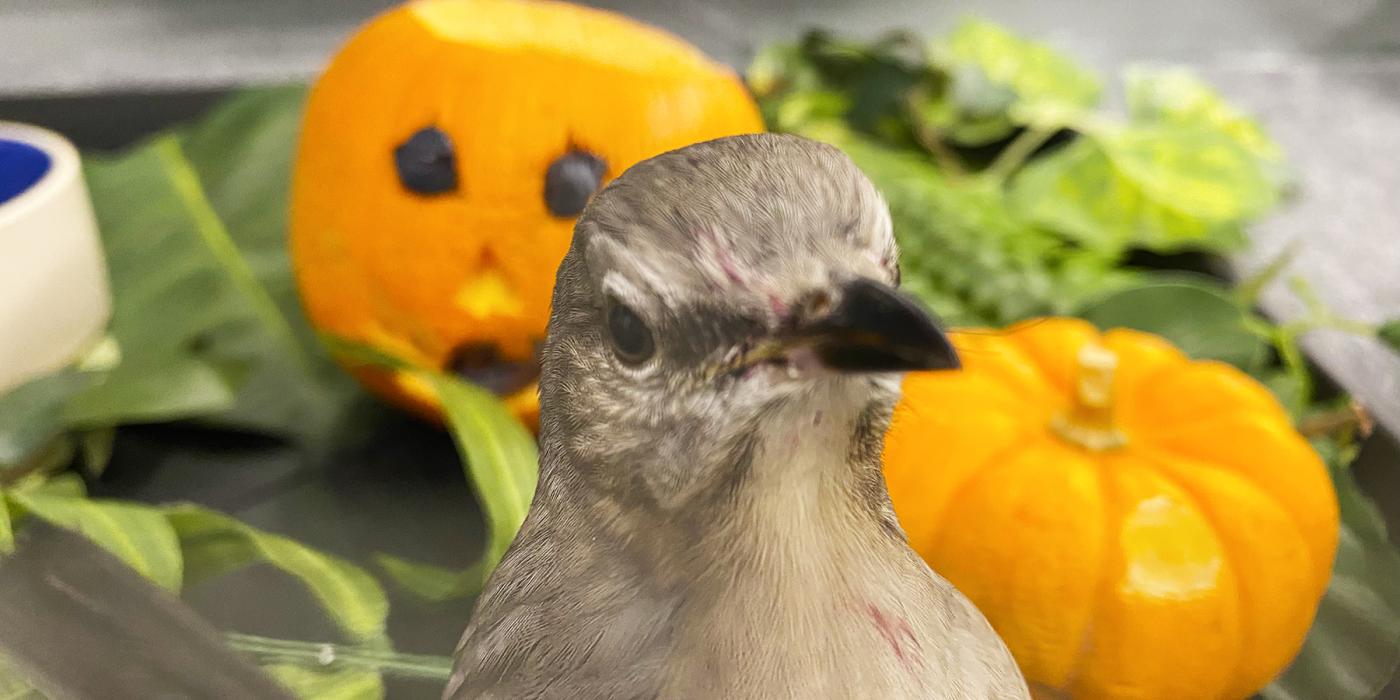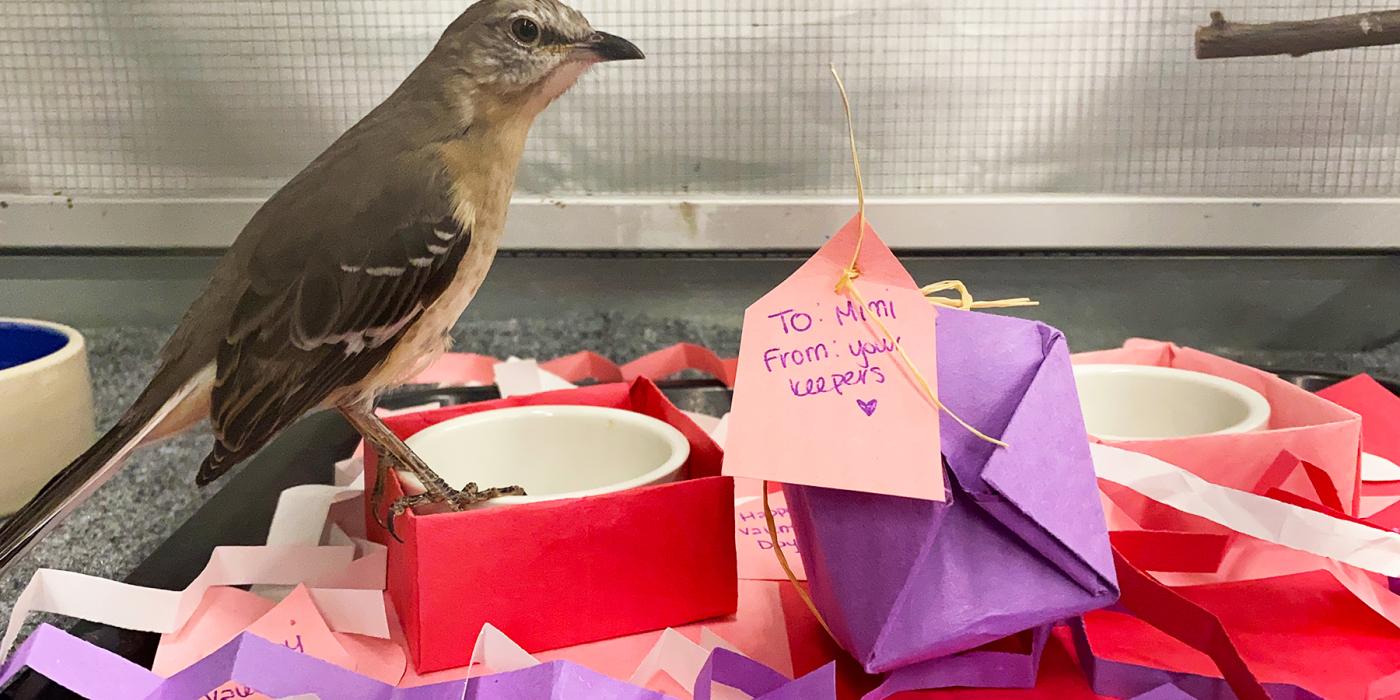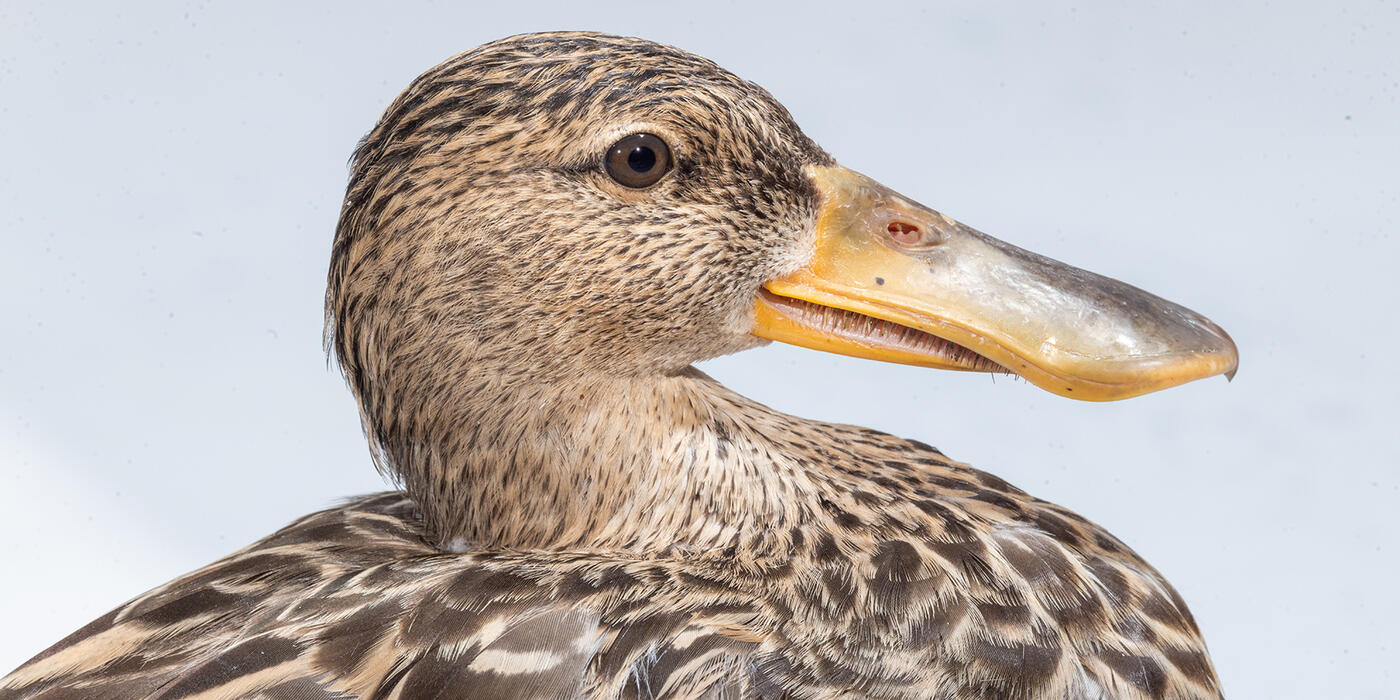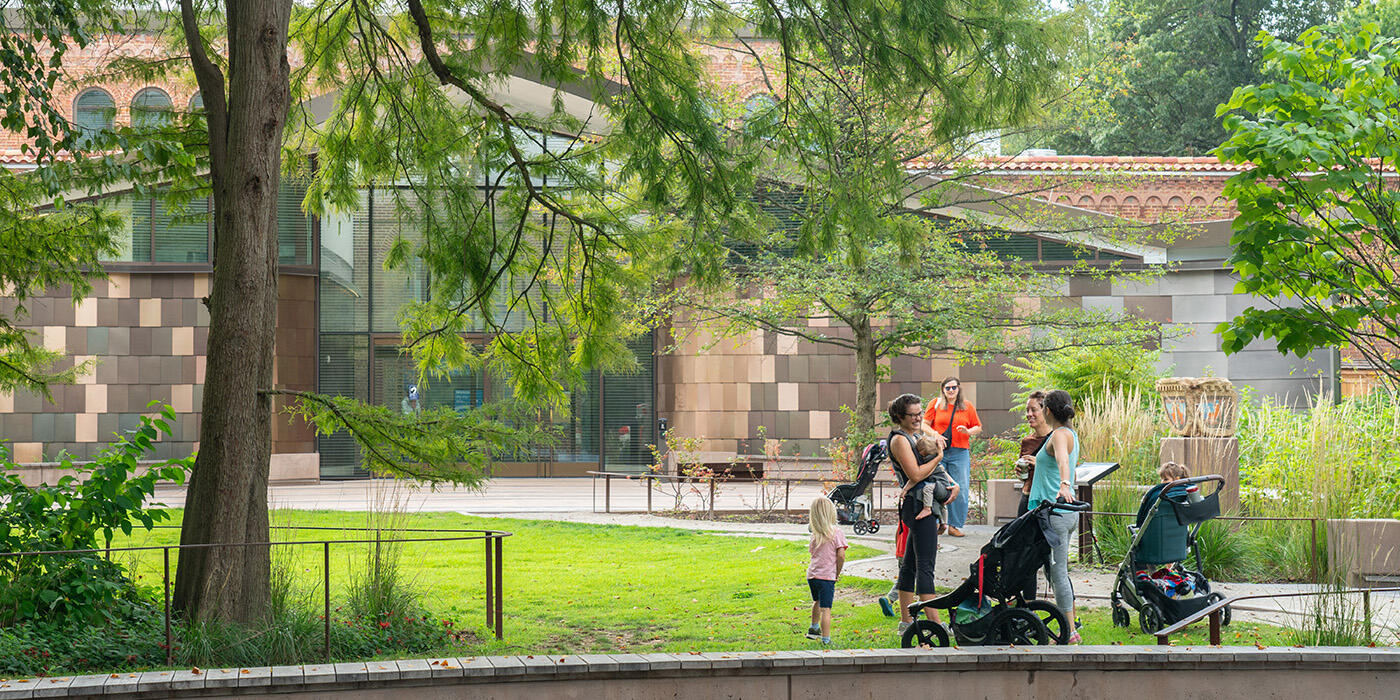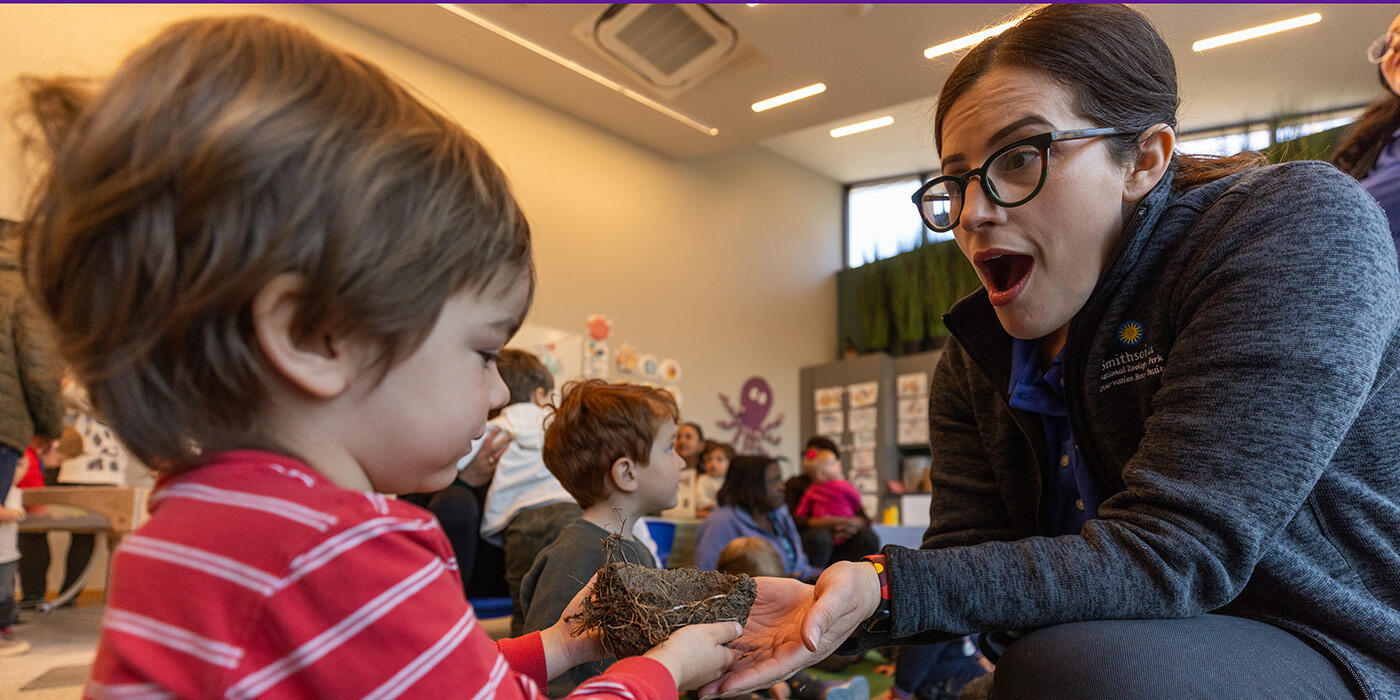Meet Mimi, A Little Mockingbird With a Big Personality
Did you know mockingbirds can mimic up to 200 calls, from another songbird species’ melodious tweet to a car’s alarm? Meet Mimi, a 1.5-year-old female mockingbird and animal ambassador in training! Hear more about Mimi’s amazing abilities, personality quirks and training triumphs in this Q+A with Bird House keeper Shelby Burns. This interview was conducted by media relations intern Janelle Dunn.
How did Mimi come to live at the Zoo?
When Mimi was a young chick, she fell out of her parents’ nest. A person spotted Mimi and scooped her up. Since this individual was not trained to care for wildlife and did not know what to feed her, they brought her to Florida Wildlife Hospital in Melbourne, Florida.
Rehabilitation centers often care for animals until they are healthy enough to be released in the wild. However, some animals become very dependent on humans or are drawn to people for food or shelter. Mimi was more interested in interacting with rehabilitation staff than other birds—so much so that she often sat on their shoulders.
Because Mimi had imprinted (social bonded) on humans, it was clear that she would not fare well if released into the wild. When we took her under our wing about a year ago, we found her interest in interacting with us so endearing and knew she would make a wonderful ambassador for her species. A fun fact about Mimi is that her name was inspired by her species’ family name—Mimidae!
What is Mimi’s personality like?
When Mimi first arrived at the Zoo, she was shy around us. Now, she perceives us as being part of her flock. Whenever we enter the room, she enthusiastically greets us by hopping around her enclosure. She can be a bit of a diva if you do not greet her and match her enthusiasm and will make her displeasure known by vocalizing and climbing the enclosure mesh to greet you!
Normally, Mimi is very sweet, but she can be particular about her diet. Her favorite food is waxworms, and when we offer those to her, she snatches them from our fingertips. If we try to feed her seeds, fruits or vegetables—anything that she perceives to be less desirable—she will hang back until we offer her what she really wants: waxworms.
Does she have a favorite enrichment item or toy?
In general, songbirds tend to be neophobic, or wary of new things in their environment. However, Mimi is not! She is very curious and eager to explore her enrichment and will often do a “wing-flash” display, where she repeatedly raises and lowers her wings.
Foraging for bugs is one of Mimi’s favorite activities. To make it a fun challenge, we hide the bugs in a box filled with shredded paper. When we arrive at work the next morning, there is paper everywhere as if she had been playing with it all night. Another version of this foraging exercise involves a wooden puzzle box. We hide mealworms and waxworms in the drawers, and she has to pull the string and manipulate the boxes to get the treats inside. She figured that one out quickly, but she still enjoys it!
Do you plan to breed Mimi?
Because Mimi is imprinted, she probably would not be a good candidate for breeding and we have no plans to do so. That said, we provide her with nesting materials so she has an opportunity to exhibit her natural behaviors. She receives pine needles, leaves and shredded newspaper, which seems to be her favorite.
We also provided nest cups that are designed to resemble the ones this species creates in the wild, but she chose not to use them. Instead, she built a little nest out of a few sticks. It did not have a nest shape, but she worked very hard at it.
Mimi is housed alone, so although she did lay a few eggs, they were all infertile. Unfortunately, her natural mothering instincts just aren’t there. She would rather interact with me than incubate her eggs.
What has been your favorite moment working with Mimi?
Mimi’s progress with training has come a long way since she arrived at the Zoo. It has been so rewarding to earn her trust and see her personality shine. Because Mimi is accustomed to spending time with people, it gives me the unique opportunity to train her outside her enclosure.
One of the behaviors that we train is called a “recall.” That is when Mimi flies out of her enclosure and lands in my hand. That is a work in progress, mostly because she has so much fun exploring the room.
Earlier this summer, Mimi would sit on our shoulder, or on an object, as we brought her back to the enclosure. Now, she has progressed in her training. She flies back to the enclosure on her own time after she is done exploring.
It’s not quite on a cue, but she is enjoying her time exploring and is motivated to come back to her enclosure without persuasion. This is a good sign that she is getting enough mental stimulation in her enclosure as well as outside playtime.
What do you hope visitors learn from Mimi?
Walking through our Delaware Bay, Prairie Pothole and Bird Friendly Coffee Farm aviaries, local visitors might recognize some familiar faces. Many of the songbirds, shorebirds and waterfowl in the Zoo’s collection also live in our neighborhoods!
Normally, we can only observe these birds from a distance. These immersive habitats allow visitors to see all our animal ambassadors up close. I hope they take a moment to appreciate their beauty and, ultimately, walk away with a deeper connection to the birds in their own backyard.
As Mimi’s recall training progresses, we hope to introduce her to visitors during special animal encounter demonstrations!
I want to help mockingbirds! What can I do?
Migratory birds, as a whole, need our help. Since 1970, North America has seen a cumulative loss of 3 billion birds. Mockingbirds, which are native to North America, are considered a species of least concern by the International Union of Conservation of Nature.
Although their populations are stable at the moment, they can still use our help to survive and thrive in the wild. There are seven simple actions we can all take to live bird-friendly; but I’d like to highlight two of them.
First, songbirds play a critical role in our ecosystem as pollinators; they help bring about the flowers, fruits and vegetables that we enjoy—including coffee and cocoa. You can help birds by creating a welcoming environment for them. To get started, find out which plants are (and are not) native to your area. Your local Native Plant Society is a great resource for pollinator-friendly plants. Bird feeders and baths, too, can attract animals to your yard; however, it is important to clean them often—at least once every two weeks—to avoid fostering the spread of diseases.
Second, if you have a pet cat, keep it indoors. Free roaming domestic cats are one of the biggest threats to mockingbirds and other songbird species, since they are not equipped to fight, and their natural defense is to try to hide.
I can’t wait for visitors to see our beautiful new Bird House when it reopens in early 2023 and meet Mimi, our mockingbird ambassador! In the meantime, I hope you’ll explore more ways to help birds in your own backyard by checking out these tips from our Migratory Bird Center on how to create a bird-friendly home.
This story appears in the September 2022 issue of National Zoo News. Want more stories about birds? Meet our two blue-billed curassow chicks, Aluna and Lulo!

